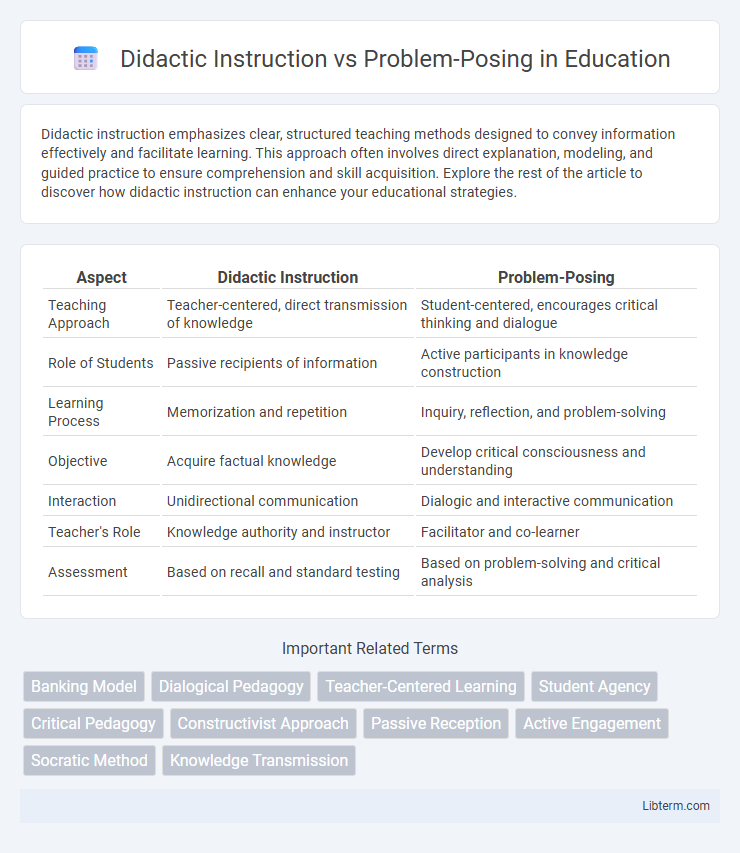Didactic instruction emphasizes clear, structured teaching methods designed to convey information effectively and facilitate learning. This approach often involves direct explanation, modeling, and guided practice to ensure comprehension and skill acquisition. Explore the rest of the article to discover how didactic instruction can enhance your educational strategies.
Table of Comparison
| Aspect | Didactic Instruction | Problem-Posing |
|---|---|---|
| Teaching Approach | Teacher-centered, direct transmission of knowledge | Student-centered, encourages critical thinking and dialogue |
| Role of Students | Passive recipients of information | Active participants in knowledge construction |
| Learning Process | Memorization and repetition | Inquiry, reflection, and problem-solving |
| Objective | Acquire factual knowledge | Develop critical consciousness and understanding |
| Interaction | Unidirectional communication | Dialogic and interactive communication |
| Teacher's Role | Knowledge authority and instructor | Facilitator and co-learner |
| Assessment | Based on recall and standard testing | Based on problem-solving and critical analysis |
Understanding Didactic Instruction
Didactic instruction is a teacher-centered approach emphasizing clear presentation of concepts and direct transmission of knowledge, often through lectures and demonstrations. This method prioritizes structured lessons where information is systematically delivered to ensure students grasp foundational content efficiently. Understanding didactic instruction involves recognizing its role in providing essential skills and factual knowledge before engaging students in more interactive or critical thinking activities like problem-posing.
Exploring Problem-Posing Education
Problem-posing education, pioneered by Paulo Freire, emphasizes critical thinking by engaging students in dialogue and reflection on real-world problems, contrasting with didactic instruction's one-way transmission of knowledge. This approach fosters active learning, empowering students to question and co-create knowledge through collaborative problem-solving. Exploring problem-posing education reveals its potential to transform traditional pedagogy by prioritizing student agency and social awareness.
Historical Origins of Both Approaches
Didactic instruction traces its roots to the traditional classroom model established in Ancient Greece, where knowledge was transmitted directly from teacher to student through lectures and rote memorization. Problem-posing education emerged from Paulo Freire's critical pedagogy in the 1960s, emphasizing dialogue and student-driven inquiry to foster critical thinking and empowerment. These contrasting approaches reflect a shift from authoritative teaching methods to participatory learning models in educational history.
Core Principles of Didactic Teaching
Didactic instruction centers on structured knowledge transfer where the teacher directs content delivery, emphasizing clarity, repetition, and mastery of core concepts. Core principles include a sequential curriculum, measurable learning objectives, and instructor-led explanations designed to ensure learners grasp foundational information. This method prioritizes teacher authority and standardized assessment to facilitate efficient skill acquisition and knowledge retention.
Key Features of Problem-Posing Methods
Problem-posing methods emphasize active learner engagement by encouraging critical thinking, dialogue, and real-world problem exploration, contrasting with the passive reception characteristic of didactic instruction. These methods foster collaborative knowledge construction, promote questioning, and stimulate creativity through open-ended challenges that connect curriculum content with students' experiences. Key features include student-centered inquiry, iterative reflection, and the development of problem-solving skills that extend beyond rote memorization.
Comparing Student Engagement Levels
Didactic instruction typically involves passive learning where students receive information directly from the teacher, often resulting in lower engagement levels. In contrast, problem-posing encourages active participation by presenting students with real-world challenges, fostering critical thinking and higher cognitive involvement. Studies show that problem-posing methods significantly enhance student engagement by promoting dialogue, collaboration, and deeper understanding of the material.
Cognitive Outcomes: Rote Learning vs Critical Thinking
Didactic instruction emphasizes memorization and repetition, often resulting in rote learning where students recall information without deep understanding. Problem-posing education fosters critical thinking by engaging students in dialogue and real-world problem-solving, encouraging analysis, evaluation, and synthesis of knowledge. Research shows problem-posing approaches enhance cognitive outcomes by promoting higher-order thinking skills compared to traditional didactic methods.
Teacher’s Role in Each Instructional Method
Didactic instruction positions the teacher as the primary source of knowledge, delivering structured content and guiding students through predetermined lessons to ensure comprehension. In problem-posing instruction, the teacher acts as a facilitator, encouraging student inquiry and critical thinking by presenting real-world problems that require collaborative exploration and reflection. This shift from information delivery to active engagement fosters deeper understanding and cultivates autonomous learning skills.
Practical Applications in Modern Classrooms
Didactic instruction emphasizes structured, teacher-led delivery of content, ideal for foundational knowledge acquisition and standardized testing environments. Problem-posing encourages critical thinking and student engagement by presenting real-world scenarios that require active problem-solving, fostering deeper understanding and collaboration. Integrating both approaches in modern classrooms enhances cognitive development and adaptability, preparing students for complex, dynamic challenges.
Choosing the Best Approach: Contextual Considerations
Choosing between didactic instruction and problem-posing depends heavily on the learning context, student needs, and educational goals. Didactic instruction excels in conveying foundational knowledge efficiently, particularly in environments requiring structured, standardized content delivery. Problem-posing fosters critical thinking and engagement, making it ideal for contexts emphasizing creativity, collaboration, and real-world problem-solving skills.
Didactic Instruction Infographic

 libterm.com
libterm.com